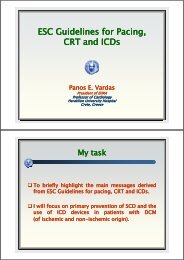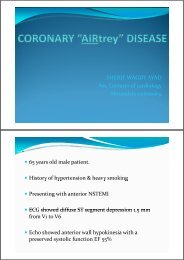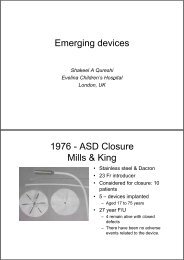Infra popliteal âTibialâ Angioplasty popliteal âTibialâ Angioplasty Infra ...
Infra popliteal âTibialâ Angioplasty popliteal âTibialâ Angioplasty Infra ...
Infra popliteal âTibialâ Angioplasty popliteal âTibialâ Angioplasty Infra ...
You also want an ePaper? Increase the reach of your titles
YUMPU automatically turns print PDFs into web optimized ePapers that Google loves.
<strong>Infra</strong>-<strong>popliteal</strong> “Tibial” <strong>Angioplasty</strong>For Critical Chronic Lower LimbIschemiaWael Shaalan, M.D.Lecturer of Vascular Surgery,University of AlexandriaCARDIO ALEX 2010, 8-11 June, Bibliotheca Alexandrina<strong>Infra</strong>-<strong>popliteal</strong> “Tibial” <strong>Angioplasty</strong>
<strong>Infra</strong>-<strong>popliteal</strong> “Tibial” <strong>Angioplasty</strong>Chronic Critical Limb Ischemia: DefinitionIs a manifestation of peripheral arterial diseasethat describes patients with typical chronicischemic rest pain or patients with ischemic skinlesions, either ulcers or gangrene. gThe termshould be used in relation to chronic ischemicdisease defined as symptoms for more than 2weeks<strong>Infra</strong>-<strong>popliteal</strong> “Tibial” <strong>Angioplasty</strong>Chronic Critical Limb Ischemia
<strong>Infra</strong>-<strong>popliteal</strong> “Tibial” <strong>Angioplasty</strong>Chronic Critical Limb Ischemia: Fate<strong>Infra</strong>-<strong>popliteal</strong> “Tibial” <strong>Angioplasty</strong>Chronic Critical Limb Ischemia: Pathology- Typically, Patients with CLI have multilevel disease- Combined iliac, femoral and tibial disease: 8%- Combined femoral and tibial disease: 60%- Isolated tibial disease: 32%
<strong>Infra</strong>-<strong>popliteal</strong> “Tibial” <strong>Angioplasty</strong>Graziani Classification Scheme for patients with CLI 2ry to multilevel diseaseGraziani et al. Eur J Vasc Endovasc Surg 2007; 33: 453-460<strong>Infra</strong>-<strong>popliteal</strong> “Tibial” <strong>Angioplasty</strong>The typical patient group of complex below-the-knee lesions represents an increasingpopulation due to the increasing prevalenceof diabetes and end-stage renal failure withabout 60-70% of patients t are diabetics
<strong>Infra</strong>-<strong>popliteal</strong> “Tibial” <strong>Angioplasty</strong>Tibial arterial occlusions are associatedmore commonly with limb threateningischemia owing to the paucity of collateralbeds, causing an advanced form of distalischemiai<strong>Infra</strong>-<strong>popliteal</strong> p “Tibial” <strong>Angioplasty</strong>Indications of infra-<strong>popliteal</strong> angioplastyResults are not durable enough to justify the use of infra-<strong>popliteal</strong> angioplasty for purposes other than limb salvage inCLI:- Patients who are poor candidates for surgery- Those having multiple co-morbidities- Life expectancy of less than 1-2 years- Those who do not have adequate conduit for bypass surgery
<strong>Infra</strong>-<strong>popliteal</strong> “Tibial” <strong>Angioplasty</strong>Contra-indications of infra-<strong>popliteal</strong> angioplasty inpatients with CLI:- Patients with extensive necrosis requiring amputation- Bedridden patients with gangrene- Patients with short life expectancy 2ry to co-morbidconditions<strong>Infra</strong>-<strong>popliteal</strong> “Tibial” <strong>Angioplasty</strong>The primary goal of endovascular therapy isthe re-establishment t of pulsatile, straight-lineflow to the foot. This results in relievingischemic i pain, healing of ischemic i ulcers,preventing limb loss, improving quality of lifeand potentially ti prolong survival
<strong>Infra</strong>-<strong>popliteal</strong> “Tibial” <strong>Angioplasty</strong>Balloon angioplasty is the currentlyestablished therapy for Below-The-Kneeendovascular interventionti<strong>Infra</strong>-<strong>popliteal</strong> p “Tibial” <strong>Angioplasty</strong>Selection criteriaNot all tibial lesions need to be treated and selecting thetibial artery with the best distal reconstruction should bethe target of choiceComplexity of the lesion also dictates attention, since astenosis even in a less dominant artery may takeprecedence over a long occlusion of a dominant arteryMultiple tibial arteries can be treated (if acceptable risk)Multiple tibial arteries can be treated (if acceptable risk),when feasible to maximize flow to the foot
<strong>Infra</strong>-<strong>popliteal</strong> “Tibial” <strong>Angioplasty</strong>ToolsACCESS SITES• Ipsilateral antegrade or contralateral femoral with crossover• Retrograde pedal approachSHEATHS• The use of long sheaths that extends down to the level of the <strong>popliteal</strong>artery has the advantage of reducing contrast load and improving imagequalityWIRES• Small caliber wires: 0.014-inch and 0.018-inch• Hydrophilic wires<strong>Infra</strong>-<strong>popliteal</strong> “Tibial” <strong>Angioplasty</strong>BALLOONSTools• Smaller profile balloons (1.5-4 mm) improve crossability• Long balloons (up to 22 cm) allow few inflations• Drug-eluting balloons: reduce restenosisStents- Indicated for inadequate PTA or occurance of dissection and thrombosisq- Balloon or self-expandable stents: restenosis- Drug-eluting stents
<strong>Infra</strong>-<strong>popliteal</strong> “Tibial” <strong>Angioplasty</strong>Case 154ys Male patient, SmokerDiabetic, C/O of Rest painand heel ulcer, ABI 0.45<strong>Infra</strong>-<strong>popliteal</strong> p “Tibial” <strong>Angioplasty</strong>
<strong>Infra</strong>-<strong>popliteal</strong> p “Tibial” <strong>Angioplasty</strong><strong>Infra</strong>-<strong>popliteal</strong> p “Tibial” <strong>Angioplasty</strong>
<strong>Infra</strong>-<strong>popliteal</strong> p “Tibial” <strong>Angioplasty</strong><strong>Infra</strong>-<strong>popliteal</strong> p “Tibial” <strong>Angioplasty</strong>
<strong>Infra</strong>-<strong>popliteal</strong> “Tibial” <strong>Angioplasty</strong><strong>Infra</strong>-<strong>popliteal</strong> p “Tibial” <strong>Angioplasty</strong>
<strong>Infra</strong>-<strong>popliteal</strong> p “Tibial” <strong>Angioplasty</strong><strong>Infra</strong>-<strong>popliteal</strong> p “Tibial” <strong>Angioplasty</strong>
<strong>Infra</strong>-<strong>popliteal</strong> “Tibial” <strong>Angioplasty</strong><strong>Infra</strong>-<strong>popliteal</strong> “Tibial” <strong>Angioplasty</strong>Follow upJust before PTA 2 months after PTA 1 year after PTA
<strong>Infra</strong>-<strong>popliteal</strong> p “Tibial” <strong>Angioplasty</strong>Case 260 ys female patientwith ischemic footulcer and rest pain<strong>Infra</strong>-<strong>popliteal</strong> p “Tibial” <strong>Angioplasty</strong>
<strong>Infra</strong>-<strong>popliteal</strong> “Tibial” <strong>Angioplasty</strong><strong>Infra</strong>-<strong>popliteal</strong> p “Tibial” <strong>Angioplasty</strong>
<strong>Infra</strong>-<strong>popliteal</strong> p “Tibial” <strong>Angioplasty</strong><strong>Infra</strong>-<strong>popliteal</strong> p “Tibial” <strong>Angioplasty</strong>
<strong>Infra</strong>-<strong>popliteal</strong> p “Tibial” <strong>Angioplasty</strong>
<strong>Infra</strong>-<strong>popliteal</strong> p “Tibial” <strong>Angioplasty</strong><strong>Infra</strong>-<strong>popliteal</strong> p “Tibial” <strong>Angioplasty</strong>Case 3CTA Pre-PTA Post-PTA
<strong>Infra</strong>-<strong>popliteal</strong> “Tibial” <strong>Angioplasty</strong>ResultsLiterature supporting infra-<strong>popliteal</strong> endovascularinterventions consists mainly of case series andretrospective reviews lacking multicentricprospective trials<strong>Infra</strong>-<strong>popliteal</strong> “Tibial” <strong>Angioplasty</strong>Results- Excellent technical success rates 88-90%- Low frequency of complications- High limb salvage rate “1ry and 2ry” of about 75-95%even in patients with long segment and diffuse disease- Re-stenosis rate between 30% for short stenoses up to80% for long occlusions- Negative predictors: Dialysis patients, 0/1 vessel runoff,and failure to improve runoff to the foot
<strong>Infra</strong>-<strong>popliteal</strong> “Tibial” <strong>Angioplasty</strong>ResultsBASIL trial “Bypass vs. <strong>Angioplasty</strong> in Severe Ischemia ofThe Leg” where 452 patients with CLI from infra-inguinaldisease, over a period of 5 years, were randomized to eitherbypass surgery-first or PTA-first strategy- Peri-operative morbidity and mortality were higher with surgery-Amputation-free survival was similar in both groups in mid-term period- Hospital costs were higher with surgery- Re-interventions were more common with angioplasty- After 2 years, surgery has reduced risk of amputation- Recommendations: PTA is recommended for patients with significantco-morbidities and with life expectancy of less than 1-2 years.<strong>Infra</strong>-<strong>popliteal</strong> “Tibial” <strong>Angioplasty</strong>Recommendations
<strong>Infra</strong>-<strong>popliteal</strong> “Tibial” <strong>Angioplasty</strong>Recommendations<strong>Infra</strong>-<strong>popliteal</strong> “Tibial” <strong>Angioplasty</strong>Recommendations
<strong>Infra</strong>-<strong>popliteal</strong> “Tibial” <strong>Angioplasty</strong>Recommendations<strong>Infra</strong>-<strong>popliteal</strong> “Tibial” <strong>Angioplasty</strong>MessageTibial angioplasty seems to be a valuable treatment optionto prevent major amputation in patients with CLI who arefacing amputation due to lack of surgical optionsBelow-the-knee angioplasty is no longer considered ahigh-risk vascular bedIntervention is rewarded with limb salvage
<strong>Infra</strong>-<strong>popliteal</strong> “Tibial” <strong>Angioplasty</strong>“Always contact a vascular interventionalspecialist before amputating a patientwith critical limb ischemia”i
<strong>Infra</strong>-<strong>popliteal</strong> “Tibial” <strong>Angioplasty</strong>“Always contact a vascular interventionalspecialist before amputating a patientwith critical chronic Lower limb ischemia”i
<strong>Infra</strong>-<strong>popliteal</strong> p “Tibial” <strong>Angioplasty</strong>Tips and TricksContralateral approach: Common femoral artery disease is presentObese patients, Proximal SFA disease, groin scarIpsilateral approach: Patients with extremely calcifiedAngulated aorto-iliac segmentPrevious aorto-bifemoral graftUsing a long sheath that extends down to the level of the <strong>popliteal</strong> artery hasthe advantage of reducing contrast load and improving image qualityImaging of the tibial vessels: oblique viewsUse hydrophilic wires and almost never use .035-inch wires in the tibialarteries because they promote much spasm, which is not typically seen using.014-inch or .018-inch wires.<strong>Infra</strong>-<strong>popliteal</strong> “Tibial” <strong>Angioplasty</strong>Tips and TricksIf the patient complains of pain during wire crossing, this always means yourwire is sub-adventitial or perforating, so stop and take a look before movingaheadIf balloon angioplasty is used, long inflations at low pressures with balloonsthat are typically 2.5 to 4 mm in diameter is used. For diffuse disease, longerballoons are superior to overlapping inflations with a short balloonSpasm can be avoided by using low-diameter wires, but if it occurs, intra-arterial nitroglycerin i works wellTibial perforations can almost always be managed easily. Tibial arteryperforations that occur as a result of guide wire penetration through anocclusion are benign because the vessel is occluded
<strong>Infra</strong>-<strong>popliteal</strong> “Tibial” <strong>Angioplasty</strong>However, the current results of balloon angioplastystudies show a 1-year restenosis rate between 30% forshort stenoses treatment and up to 80% followingrecanalization of an occlusion<strong>Infra</strong>-<strong>popliteal</strong> p “Tibial” <strong>Angioplasty</strong>
















